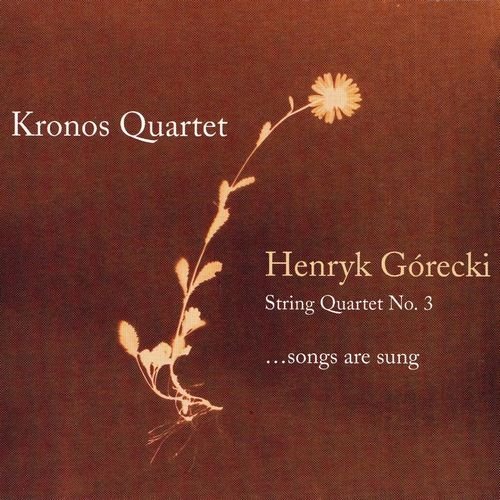Kronos Quartet - Henryk Gorecki: String Quartet No. 3 ...songs are sung (2007)

Artist: Kronos Quartet
Title: Henryk Gorecki: String Quartet No. 3 ...songs are sung
Year Of Release: 2007
Label: Nonesuch
Genre: Classical
Quality: FLAC (image+.cue,log)
Total Time: 50:15
Total Size: 195 Mb
WebSite: Album Preview
Tracklist: Title: Henryk Gorecki: String Quartet No. 3 ...songs are sung
Year Of Release: 2007
Label: Nonesuch
Genre: Classical
Quality: FLAC (image+.cue,log)
Total Time: 50:15
Total Size: 195 Mb
WebSite: Album Preview
H. M. Gorecki (b.1933-)
String Quartet No. 3 ...songs are sung
1. I. Adagio-Molto Andante-Cantabile 10:34
2. II. Largo, Cantabile 10:59
3. III. Allegro, Sempre ben marcato 4:22
4. IV. Deciso-Espressivo ma ben tenuto 11:26
5. V. Largo-Tranquillo 12:36
Performers:
Kronos Quartet:
David Harrington, violin
John Sherba, violin
Hank Dutt, viola
Jeffrey Ziegler, cello
The essay in the program booklet for this release of Górecki's String Quartet No. 3 (...songs were sung), makes much of a supposed caesura in Górecki's creative output following the phenomenal success of Nonesuch's 1992 release of this Third Symphony, with soprano Dawn Upshaw, which elevated him practically to the level of a pop star. The essay implies that his meteoric rise to being one of the most famous and popular contemporary composers may have produced a creative crisis that caused him to wait until 2005 to finally deliver the score of his Third Quartet, which he had written in the winter of 1994-1995. In fact, Górecki's sudden notoriety seems to have had little effect on his creativity; between 1993 and 2004, he wrote 16 opus numbers.
The String Quartet No. 3 inhabits much the same musical and emotional universe as the composer's Third Symphony and the earlier string quartets -- an overwhelming sense of sadness followed by a cathartic peacefulness, created by the use of figural repetition; predominantly slow tempos, which are very occasionally punctuated by faster, often ironic, outbursts; the use of melancholy, folk-like melodies; and mildly dissonant minor key chorale-like textures that tend toward harmonic stasis. The five-movement quartet is constructed in a loose arch form, with material from the first movements repeated in the last movements and an ending that mirrors the beginning. The composer throws in enough surprises, such as a surprisingly stolid and romantic theme that appears in the third and fourth movements, to relieve the quartet's darkness. The response to the composer's Third Symphony will be a good indicator of the listener's appreciation of this quartet because it shares so many qualities with that work. The Kronos Quartet, which commissioned the piece, gives it a technically superlative and emotionally wrenching performance. Nonesuch's sound is intimate and warm, with excellent balance.
The String Quartet No. 3 inhabits much the same musical and emotional universe as the composer's Third Symphony and the earlier string quartets -- an overwhelming sense of sadness followed by a cathartic peacefulness, created by the use of figural repetition; predominantly slow tempos, which are very occasionally punctuated by faster, often ironic, outbursts; the use of melancholy, folk-like melodies; and mildly dissonant minor key chorale-like textures that tend toward harmonic stasis. The five-movement quartet is constructed in a loose arch form, with material from the first movements repeated in the last movements and an ending that mirrors the beginning. The composer throws in enough surprises, such as a surprisingly stolid and romantic theme that appears in the third and fourth movements, to relieve the quartet's darkness. The response to the composer's Third Symphony will be a good indicator of the listener's appreciation of this quartet because it shares so many qualities with that work. The Kronos Quartet, which commissioned the piece, gives it a technically superlative and emotionally wrenching performance. Nonesuch's sound is intimate and warm, with excellent balance.
[center][/center]






![Frank Sinatra - Christmas (Remastered) (2013) [Hi-Res] Frank Sinatra - Christmas (Remastered) (2013) [Hi-Res]](https://www.dibpic.com/uploads/posts/2025-12/1765618088_fsc500.jpg)

